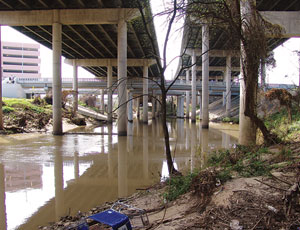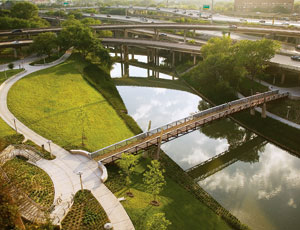Need to stop flooding or reduce stormwater runoff and sewer overflows? Looking to ease demand on treatment plants and avoid the cost of expansion? Seeking cleaner air or water? Interested in recharging an aquifer, rebuilding a shoreline or remediating a brownfield? Trying to stem highway pollution? Need to rebalance a watershed or ecosystem?

Photo: SWA Group
If so, a landscape architect may be in your future. The design professional—until recently derided as little more than a glorified gardener—is on a campaign to reclaim a seat at the environmental cleanup table. Some are even bent on sitting at the head, leading the engineers.
The movement is variously called performance-based, ecological, sustainable or green landscape architecture. Some use the terms “landscape infrastructure” or “landscape urbanism”. A rose by any name would smell as sweet, not only to landscape architects, long suffering from low self-esteem, but to localities seeking economical, less invasive and more beautiful ways to deal with the poisons of development.
This form of landscape architecture harks back to the profession’s roots. In a decade, it has gone from “obscurity to mainstream,” says David Yocca, a principal in the Elmhurst, Ill., office of Conservation Design Forum, a planner, landscape designer and engineer.
This dramatic change signals a comeback for a group that had lost its way in the 1980s and 1990s. During that time, within the profession, there was a “backlash against environmentalism and a view that the environmental movement had shorted esthetic concerns,” says Fritz Steiner, dean of the School of Architecture at the University of Texas, Austin. On the contrary, “environmentalism and esthetics are complementary,” he says.
Even geotechnical engineers, who often work with landscape architects, see the discipline’s renaissance. “We were absolutely not doing [ecological landscape architecture] 10 years ago,” says Christopher A. Robertson, a vice president at Shannon & Wilson Inc., a Seattle-based geotechnical and environmental consultant. “It is where stormwater management is headed,” he adds.
Landscape architecture, a discipline that combines nature, culture and technology, in no measure eliminates the engineer from the equation. “We have to move forward holistically,” integrating design and engineering, says Bert Gregory, CEO of Mithun, a Seattle-based architect, landscape architect and planner.
The landscape profession is growing, numbering about 30,000, including 15,000 who are licensed. Employment of landscape architects through 2014 is expected to increase 18% to 26%, faster than the average of all U.S. occupations, according to the Bureau of Labor Statistics. By contrast, BLS estimates, demand through 2012 for architects, planners, interior designers and environmental scientists will grow an average of 9% to 15%. Demand for civil engineers is expected to grow at a slower-than-average rate of 0% to 8%. Membership in the American Society of Landscape Architects (ASLA) grew from 16,586 in 2005 to 17,236 in 2008. And this year, U.S. News & World Report named landscape architecture as one of its 30 best careers.
From green roofs and green streets to waterfronts and watersheds, from exurbs to “urbs,” landscape architects are helping turn eyesores into eyefuls. They are using a combination of natural and engineered systems, including soil biofiltration and carbon sequestering, that manage and clean water and air. Permeable pavements and bioswales—depressed planters that soak up and filter stormwater runoff polluted with oils and metals—are starting to pop up in parking lots and along streets from Portland, Ore., to Philadelphia. Green roofs that absorb stormwater, insulate buildings and reduce the urban heat-island effect, are proliferating across the nation. In Houston, a derelict stormwater channel is becoming a public park. Durango, Colo., has a sustainable golf course.
Local food production through urban and suburban farming is on the horizon, much under the stewardship of...



Post a comment to this article
Report Abusive Comment